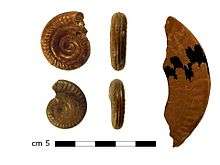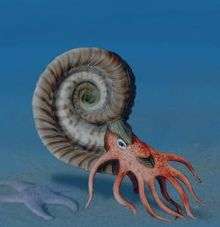Hildoceras
| Hildoceras Temporal range: Toarcian–Aalenian[1] | |
|---|---|
 | |
| Hildoceras sp. | |
| Scientific classification | |
| Kingdom: | Animalia |
| Phylum: | Mollusca |
| Class: | Cephalopoda |
| Subclass: | †Ammonoidea |
| Order: | †Ammonitida |
| Family: | †Hildoceratidae |
| Subfamily: | †Hildoceratinae |
| Genus: | †Hildoceras Hyatt, 1876 |
| Species | |
| |
Hildoceras is a genus of ammonite form the Jurassic[1] in the family Hildoceratidae. The shells are characterized by a narrow discoidal evolute shape, keeled venter, concave ribs along the outer flanks, and a shallow spiral goove running along smooth inner flanks. Whorls slightly overlap, cross sections are compressed. The ventral keel is bordered on either side by a shallow groove.

Recreation of Hildoceras
The genus was named by Alpheus Hyatt after Saint Hilda in 1876, and fossils have been found in Europe and Japan.
Distribution
Jurassic of Bulgaria, France, Germany, Hungary, Italy, Japan, Luxembourg, Serbia and Montenegro, Spain, the United Kingdom[2]
References
- Notes
- 1 2 Sepkoski, Jack (2002). "Sepkoski's Online Genus Database". Retrieved 2014-05-28.
- ↑ "Paleobiology Database - Hildoceras". Retrieved 2014-05-28.
- Bibliography
- Arkell, W.J.; Kummel, B.; Wright, C.W. (1957). Mesozoic Ammonoidea. Treatise on Invertebrate Paleontology, Part L, Mollusca 4. Lawrence, Kansas: Geological Society of America and University of Kansas Press.
This article is issued from Wikipedia - version of the 12/8/2015. The text is available under the Creative Commons Attribution/Share Alike but additional terms may apply for the media files.